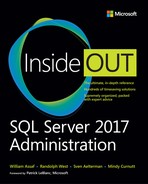Foreword
The world as we know it is being inundated with data. We live in a culture in which almost every individual has at least two devices, a smart phone, and a laptop or computer of some sort. Everything we do on these devices is constantly collecting, sharing, or producing data. This data is being used not only to help organizations make smarter decisions, but also to shape and transform how we as a society live, work, make decisions, and sometimes think.
This massive explosion can be attributed to the technological transformation that every business and nearly every industry is undergoing. Every click or purchase by an individual is now triggering some event that triggers another event that likely amounts to hundreds or possibly thousands of rows of data. Multiply this by every person in the world and now you have an unprecedented amount of stored data that no one could have ever imagined. Now, not only must organizations store this data, but also ensure that this data—this massive amount of data—is readily available for consumption at the click of a button or the swipe of a screen.
This is where the database comes into play. Databases are the backbone or back end to possibly every aspect of business today. Back when Ted Codd, the father of the relational database, came up with this seminal idea, he probably had no idea how widespread their use would be today. Initially, database usage was intended to store data and retrieve data. The primary purpose was to simply ensure the security, availability, and reliability of any information written by on-premises applications at varying scales.
Today, all of that has changed. Data must be available 24 hours per day, 7 days each week, primarily via the internet instead of just by way of on-premises applications. Microsoft SQL Server 2017 was designed with all of this in mind. It can support high-volume Online Transactional Processing (OLTP) databases and very large Online Analytical Processing (OLAP) systems out of the box. And, by taking advantage of Microsoft Azure, developers can grow and scale databases dynamically and transparently behind the scenes to accommodate planned and unplanned spikes in demand and resource utilization. In other words, the latest version of SQL Server was built to not only accommodate this new world of data, but to push the limits of what organizations are doing today and what they will be doing tomorrow and deeper into the future.
Close your eyes and imagine a world in which a DBA can configure a database system to automatically increase or decrease resource utilization based on end-user application usage. But that’s not all. What if the relational database management system (RDBMS) could automatically tune performance based on usage patterns? All of this is now possible with SQL Server and Azure SQL Database. By using features such as the Query Store and Elastic Database Pools, DBAs can proactively design solutions that will scale and perform to meet any application Service-Level Agreement.
In addition to world-class performance, these databases also include security and high-availability features that are unparalleled to any other RDBMS. Organizations can build mission-critical secure applications by taking advantage of SQL Server out-of-the-box built-in features without purchasing additional software. These features are available both in the cloud and on-premises and can be managed using SQL Server Management Studio, SQL Server Data Tools, and SQL Operations Studio. All three tools are available to download for free, and will be familiar to DBAs and database developers.
Throughout this book, the authors highlight many of the capabilities that make it possible for organizations to successfully deploy and manage database solutions using a single platform. If you are a DBA or database developer looking to take advantage of the latest version of SQL Server, this book encompasses everything needed to understand how and when to take advantage of the robust set of features available within the product.
This book is based on the skills of a group of seasoned database professionals with several decades experience in designing, optimizing, and developing robust database solutions, all based on SQL Server technology. It is written for experienced DBAs and developers, aimed at teaching the advanced techniques of SQL Server.
SQL Server, Microsoft’s core database platform, continues its maturity from supporting some of the smallest departmental tasks to supporting some the largest RDBMS deployments in the world. Each release not only includes capabilities that enhance its predecessor, but also boasts features that rival and exceed those of many competitors.
This trend continues with SQL Server 2017. This release, just like all past releases, continues to add capabilities to an already sophisticated and reliable toolkit. Features include a secure, elastic, and scalable cloud system; advanced in-memory technologies; faster and consolidated management and development experiences; and continued growth and enhancements in the area of high availability and disaster recovery. In addition, concerted efforts have been focused on making the number one secure RDBMS in the world even more secure, by adding capabilities such as row-level security, Always Encrypted, and dynamic data masking. Finally, and as always, performance is at the center of this release. With enhancements to the Query Store, DBAs can take a more proactive approach to monitoring and tuning performance.
All in all, this book is sort of like an “Inside Out” look of each of the core components of SQL Server 2017, with a few excursions into the depths of some very specific topics. Each chapter first provides and overview of the topic and then delves deeper into that topic and any corresponding related topics. Although it’s impossible to cover every detail of every Transact-SQL statement, command, feature or capability, this book provides you with a comprehensive look into SQL Server 2017. After reading each page of this book, you will be able implement a cloud-based or on-premises scalable, performant, secure, and reliable database solution using SQL Server 2017.
Patrick LeBlanc, Microsoft
